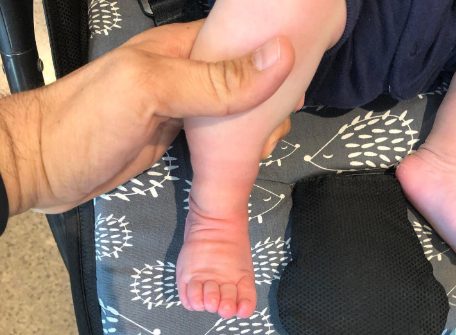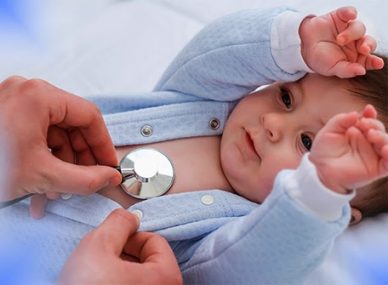A bone tumor or osteosarcoma is the most common type of cancer that starts inside the bones of a child or adolescent, usually in the arms or legs. The most common symptoms are limited movement, bone pain, a lump, and an unexplained broken bone. There are several types of treatment. The survival rate for osteosarcoma is around 70% if cancer does not spread to other parts of the body.
What is Bone Tumor or Osteosarcoma?
Cancerous tumors in the bones are called osteosarcomas. Osteosarcomas appear at first to be regular bone cells. The tumors create immature, irregular, and diseased bone, which then becomes tumors again. On average, osteosarcoma is diagnosed at an age of 15 in teenagers.
Sarcomas are cancers that develop within connective tissue, such as bone, cartilage, or muscle. The term “osteo” is used to refer to bone.
The most common site of osteosarcoma is in the long bones of the arms and legs. When you’re a teenager, it usually occurs near your bones’ ends (the metaphyses) or near your knee, the place where the fastest growth is occurring. Among the most commonly affected bones and areas are:
- Your thighbone (femur).
- Your tibia (shin bone) is near your knee.
- Your humerus (upper arm bone) is near your shoulder.
- You rarely find cancer in your abdomen or chest.
Osteosarcoma or Bone Tumor Risk in Childhood
A teenage boy is most likely to develop osteosarcoma. The disease may be associated with rapid bone growth in teens with osteosarcoma, indicating that the disease may be caused by rapid bone growth in teens.
The risk of osteosarcoma is also higher in kids who inherit one of the rare cancer syndromes. There are two types of the inherited syndrome: retinoblastoma (a malignant tumor that develops in the retina, a part of the eye), and Li-Fraumeni syndrome (a kind of inherited genetic defect).
The radiation treatment that children received for earlier cancer increases their risk of osteosarcoma because radiation also triggers DNA mutations.
Osteosarcoma or Bone Tumor: Diagnosis and Treatment
X-rays are used to detect bone changes in osteosarcoma after doctors perform a physical examination, take a detailed medical history, and analyze a physical exam and medical history.
Typically, doctors order a CT scan or magnetic resonance imaging (MRI) scan to determine where to biopsy and whether cancer has spread from the bone into nearby muscles and fat. Biopsies are performed by cutting or scraping a small piece of tissue, or by withdrawing a sample of tissue with a needle and syringe.
The needle biopsy involves taking a sample of the tumor with a long hollow needle. A local anesthetic (medicine that numbs the area so that the person will not feel pain) is typically given. As an alternative, the doctor may order an open biopsy, in which a surgeon removes a part of the tumor while the child sleeps in the operating room under general anesthesia during the procedure.
In the event of an osteosarcoma diagnosis, a CT chest scan, a bone scan, and, occasionally, more MRIs will be ordered. In the days following treatment, doctors will repeat these tests to see how well the treatment is working and whether the cancer is spreading.
Treating Bone Sarcoma or Osteosarcoma
In children, chemotherapy is used to treat bone tumors in the leg or arm or osteosarcoma (the use of medications to kill cancer cells and shrink cancer), followed by surgery to remove the cancerous cells and then more chemotherapy (to minimize the chance of cancer recurring).
Bone tumors can often be effectively removed by surgery, and chemotherapy can help eliminate the remaining cancer cells.
At Hope AMC, children with cancer of the musculoskeletal system including bone sarcoma or soft tissue sarcoma are treated with advanced techniques and effective approaches. Children and adolescents who are suffering from malignant or benign tumors of the bones, soft tissues, and musculoskeletal nerves will be treated by the Orthopedic Oncology specialists at Hope AMC.
What Types of Bone Cancer are Treated at Hope AMC?
Children of different ages – from newborns to adolescents – are treated by the Orthopedic Oncology department at Hope AMC. Children, teenagers, and young adults most often get osteosarcoma, a type of bone cancer that usually affects the legs and arms. Here at Hope AMC, we treat malignant bone tumors that are the most complex.
The Following Types of Bone Sarcomas are Treated:
- The most common childhood cancers are osteosarcomas and Ewing’s Sarcomas.
- Osteosarcoma
- Sarcomas of the bone and other types
The Following Types of Soft Tissue Sarcomas are Treated:
- Rhabdomyosarcoma
- Fibrosarcoma
- Liposarcoma
- Epithelioid Sarcoma
- Synovial Cell Sarcoma
- Angiosarcoma
- Leiomyosarcoma
- Myxofibrosarcoma
- Undifferentiated/Pleomorphic Sarcoma
- Dermatofibrosarcoma Protuberans
- Malignant Fibrous Histiocytoma
- Malignant Peripheral Nerve Sheath Tumor
The Following Benign Bone Tumors are Treated:
- Osteochondroma
- Osteoid Osteoma
- Osteoblastoma
- Enchondroma
- Chondroblastoma
- Bone Cysts
- Unicameral Bone Cyst (UBC)
- Aneurysmal Bone Cyst (ABC)
The Following Types of Benign Soft Tissue Tumors are Treated:
- Neurofibroma
- Lymphoma
- Schwannoma
- Pigmented Villonodular Synovitis (PVNS)
- Giant Cell Tumor
Despite the above-mentioned conditions, other cancerous bone tumors such as Multiple Myeloma, Lymphoma, Metastatic Carcinoma, and others, as well as non-cancerous bone and soft tissue tumors such as Fibrous Dysplasia, Ganglion Cyst, Baker’s Cyst, and benign bone tumors of the extremities, spine, and pelvis, pathologic fractures, and others, are treated at Hope AMC Medical Center in Dubai.



